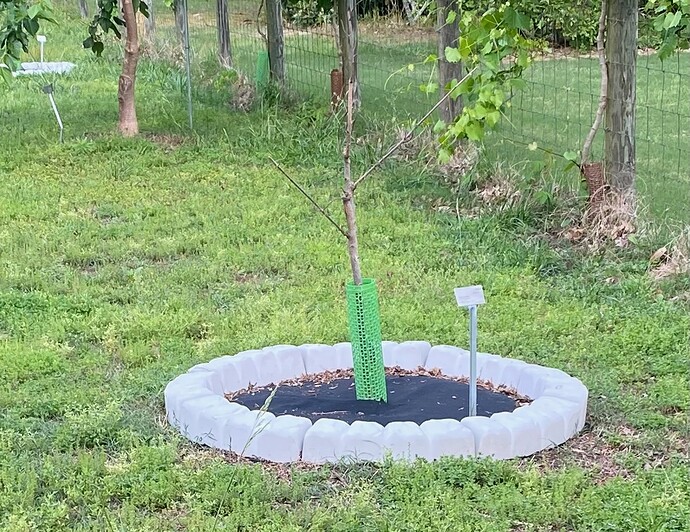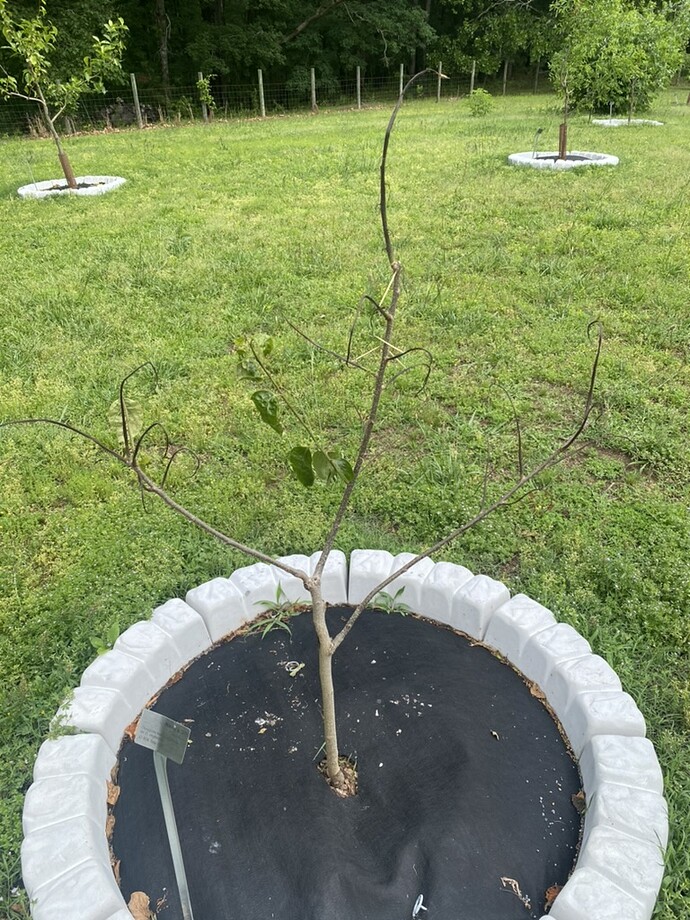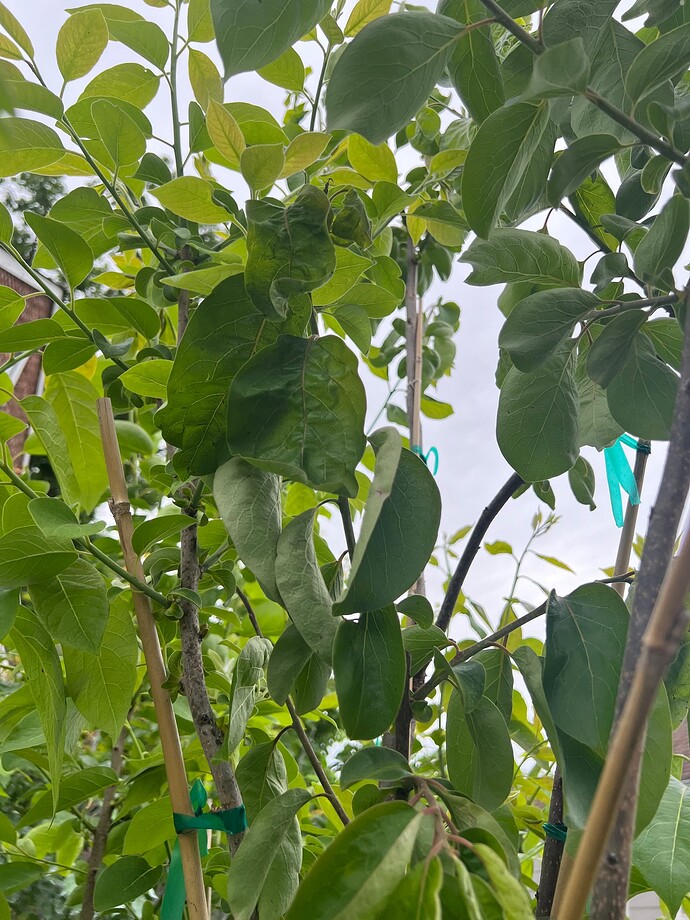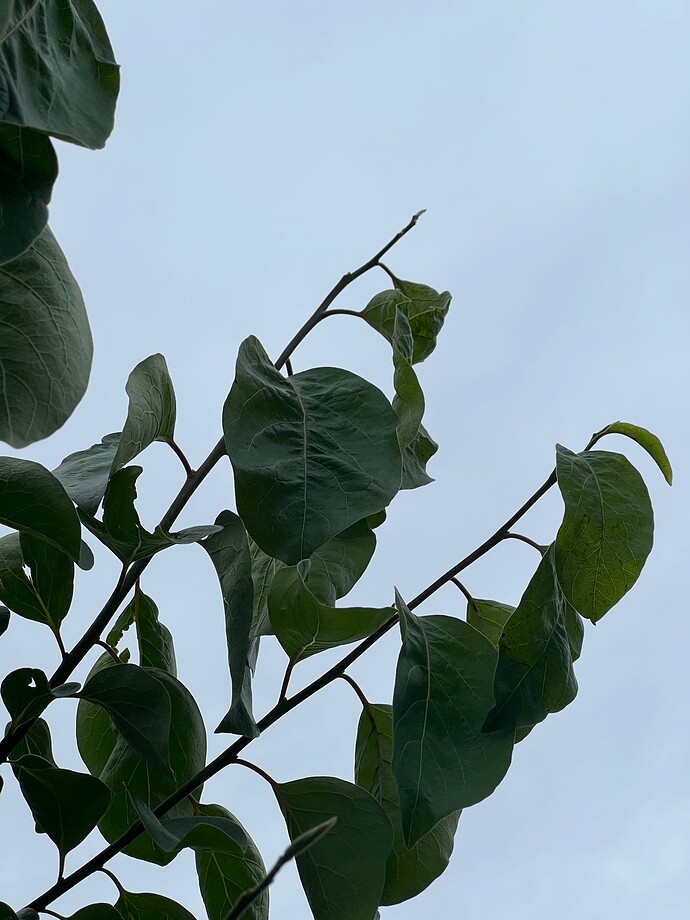Good luck! I interpreted what GrapeNut wrote above to explain why you can’t regraft to a D Virginians rootstock that has survived after the D.kaki scion succumbed to KSDS. I would expect that D lotus rootstock would either die if it isn’t resistant to KSDS or no longer accept a D kaki scion if it is resistant. It would surprise me if the rootstock confers any resistance to the disease in the scion since it always seems to start at the tips of branches and work its way down to the graft union.
As I understand based on reading this thread and others, the infected DV rootstock would no longer accept Kaki scions because when you graft a Kaki scion to infected DV, the resistent DV rootstock infects the Kaki and DV rootstock rejects the infected symptomatic Kaki scion. It’s suggested in this thread that this resistant rootstock with symptomatic scion combination plus the pathogen causes KSDS to occur.
If both DL and Kaki are symptomatic to the KSDS-causing pathogen, the pathogen could cause health issue for both DL+Kaki, but perhaps the Kaki rootstock would not reject the scion in such a dramatic manner. That is what I hypothesize could be the case, but with zero proof.
UPDATE (pictures as of May 5, 2024).
Patient Zero (the Saijo) is toast:
Similarly, Nikita’s Gift appears to be not long for this world, with only a bit of sickly new growth clinging to life:
The Fuyu continues to weaken and shed leaves, but its decline has not been quite so rapid. I wouldn’t place a bet on it, though:
I had a scare with some sort of leaf spot on a few other kaki that made me think that the SDS had spread to them, but the black veins did not appear and an application of fungicide cleared it up. I had previously eschewed spray treatments on my kaki, but now I’m taking no chances with the survivors.
I have one kaki on lotus, and it hasn’t been infected so far. However, it is in a different location and none of the kaki around it, which are on virginiana, have been infected either. I am not a fan of lotus because mine appears less vigorous and also prone to leaf out too early relative to my other persimmons, but I would change my tune in a hurry if it turns out the the combo protects against SDS. I’m not very optimistic, though.
Thank you for your thoughtful and informative post – I reread it several times and it allowed me to get through the stages of grief faster. I admit, I’ve been just a little smug when neighbors have expressed surprise about my “huge sweet persimmons” and wondering why they’ve never seen them grown here before, so maybe this is my comeuppance.
I really like old trees – having an orchard of old but still productive trees one day was my goal starting out, and so I think that’s going to bias me toward Americans, or mostly-American hybrids, for the future. I greatly appreciate your list of varieties that succumbed, and it looks like my experience puts the hex on Nikita’s Gift as well. I’m hoping that some of the hybrids with a greater proportion of American genetics, like JT-02, might prove to be immune.
I appreciate you and others sharing these sad stories and allowing less informed people like me to learn from it.
I have DV+NG, 2x(DL+Kaki), and loads of wild DV within “a stone’s throw” so I will post any finding as well.
Last year I had tried multiple times to regraft a Rosseyanka that had died, thinking it was cicada damage that did it in. That tree rejected multiple attempts to graft kaki, then hybrids, then strangely even American grafts failed, but perhaps those were just too late in the season.
I dug it out and got rid of it, but now I see my Prok that is 15 feet away, with added grafts of American, Kaki and hybrids, is showing ominous signs. I had Gora Roman Kosh on the top, plus one upper side branch and both grew great last year, started out strong this year and in the last 2 weeks have suddenly weakened with the leaves looking almost rumpled and the tips dying back. A Sosnovskaya graft and a Matsumoto Wase graft, both of which are on branches lower down still look fine and the three American varieties all look fine as well. You can see a happy Ruby branch growing in the background of some of these shots of GRK looking bad.
I’m wondering if I should just cut off the GRK now and graft an American in its place. And I’m also wondering if the Sosnovskaya and Matsumoto grafts are doomed or if it is anything like fireblight and if I cut away the bad part maybe the infection doesn’t spread. This is a bit different than other examples here, since the base tree is Prok and these are all different grafts on branches. Ugh.
Does your leaves have the characteristic “black veins” as symptomatic of KSDS?
If it’s KSDS, based on others postings, it doesn’t sound amputat-able, as the death of the scion is purported an immune response from the DV rootstock. Sap flow may stop at the graft union.
If your DV rootstock is rejecting scions, then that means whole tree is probably infected with whatever pathogen causing KSDS, and it’s your DV rootstock that’s infecting the scions. This is what I believe to be the working theory based on what’s posted in forums.
That said, I never had a successful graft to persimmon, I could never get the timing or aftercare right, so it’s challenging in itself. Others may be much more gifted. Since the difficulty of grafting persimmon is high, information about graft rejection could also be noisy.
I think there’s still a lot of research that needs to happen before we can say anything definitive, but in the meantime, I’d be curious how kaki would do on kaki, as well as lotus, rootstock. Has anyone grown out kaki seedlings in the areas with KSDS?
Those are good experiments. I have the DL+Kaki combo growing in last 4 years. I assume I am in a KSDS zone but don’t know for sure. Fingers crossed.
Bought and planted a Nikita’s Gift last fall. This spring it put out about 6 inches of beautiful new growth. Then new shoots started drying up and dying. It’s now half dead. I’m not in the SE and can’t remember where the tree came from. It’s likely a goner and I should probably just cut it down.
Sorry to hear that @fruitnut . It is painful to watch these trees fail and very frustrating that there doesn’t seem to be a lot of good information to help us understand the spread and how to stop it. Or maybe I just have missed that.
I’m wondering how much of an issue transferring by grafting might be with the disease being resident in a scion wood without the person knowing that and then it gets transferred to the new tree. I’ve collected some kaki and hybrid scions from the tree that now appears to be infected, but a quick check let me know I haven’t passed any of that on this year, so hopefully nothing gets transferred if that is one of the possible pathways. I may graft some rootstocks to the Gora Roman Kosh scion I have in the fridge to see if new trees from the scions show any signs.
I’m also wondering if the persimmon psyllid could be a possible vector since I’ve noticed it happening shortly after the psyllid activity starts in the spring. I know I get a lot of viral transmission at my community garden plot with aphids carrying mosaic virus between peppers and some other plants.
I was typing up a post just on exactly this. You read my mind. The sap sucking persimmon psyllids are also winged and highly mobile meaning they could easily communicate disease between native DV and cultivated persimmons. They appear many weeks after the leaf out which could explain why people see vigorous growth for weeks then sudden collapse.
@sockworth @zendog I have definitely observed persimmon psyllids on my kaki. They make an appearance every year, and they were there this year, too, almost exactly when the SDS symptoms started showing up.
I have never done anything about them before because they didn’t appear to even rate to the level of a nuisance. Usually, about a week after they appear, predators like wasps, ladybugs, and various small spiders join the party and make short work of them.
Perhaps they are indeed a vector for SDS, if it is in fact a pathogen.
Significant variation in symptoms is seen between diseases, though some symptoms are expressed across species. On a macroscopic scale, plants infected with a X. fastidiosa-related disease exhibit symptoms of water, zinc, and iron deficiencies,[27] manifesting as leaf scorching and stunting in leaves turning them yellowish-brown, gummy substance around leaves,[27] fruit reduction in size and quality,[27] and overall plant height. As the bacterium progressively colonizes xylem tissues, affected plants often block off their xylem tissue, which can limit the spread of this pathogen; blocking can occur in the form of polysaccharide-rich gels, tyloses, or both. These plant defenses do not seem to hinder the movement of X. fastidiosa. Occlusion of vascular tissue, while a normal plant response to infection, makes symptoms significantly worse; as the bacterium itself also reduces vascular function, a 90% reduction of vascular hydraulic function was seen in susceptible Vitis vinifera.[28] This bacterium rarely completely blocks vascular tissue. There usually is a slight amount of vascular function that keeps the plant alive, but makes its fruit or branches die, making the specific plant economically nonproductive. This can cause a massive drop on supply of quality fruit.[27] Smaller colonies usually occur throughout a high proportion of xylem vessels of a symptomatic plant.[citation needed]
X. fastidiosa is a Gram-negative, xylem-limited illness that is spread by insects. It can damage a variety of broadleaved tree species that are commonly grown in the United States. X. fastidiosa can be found in about 600 different plant species.[citation needed]
- Withering and desiccation of branches
- Leaf chlorosis
- Dwarfing or lack of growth of the plant
- Drooping appearance and shorter internodes
- Shriveled fruits on infected plants
- Premature fruit abscission
- gum-like substance on leave
- hardening and size reduction of fruit
I asked Cliff to review this thread and comment as to the possibility of being spread by insects as you seem to be observing. See his commentary posted today. In his response back to me he stated:
“ We have delt with it also and We have controled it to some extent by controling the insects and spraying Often
Sorry
Clifford England”
So I think your observations about aphids may have merit.
Dennis
Kent, wa
@KYnuttrees Thanks for your input Cliff.
So it sounds like psyllids are a vector, along with other insects. It is hard to imagine keeping those at bay without regular spraying, which is unfortunate since I hoped persimmons would be no-spray trees. I’m guessing the best practice would be to immediately cut down any trees showing signs to avoid spreading it to other trees in our orchards.
I also wonder if it can be carried in scion wood, particularly on American varieties that might carry it and show no signs. I hope we can get more people reporting if they see any issues to get a better handle on the overall risks.
A psyllid vector would suggest that the cause is not Xylella, as the bacterium is transmitted by xylem feeders, and psyllids typically only feed from the phloem. However, we would have to figure out if psyllid feeding and the appearance of symptoms is related or just coincidental.
I was sent scion 5 years ago and notified after grafting that those trees had been lost due to KSDS. The trees have grown well and remained healthy.
I have two new trees I got from Raintree only last year, and they both are not doing well with the black lines in the leaf veins and general sickly looking; They never grew well from when I got them. I wonder if they didn’t have a virus from the get-go.
Unfortunately this plus my two old trees still left also exhibiting symptoms puts a big dent in my persimmon crop. My JT-02 grafted two years ago is going like gangbusters and my Rojo Brilliante I put in two years ago is also doing well, but nothing else is. I decided to add a Smith’s Best from JFE late here because those two Raintree trees are looking so bad.
Scott- you’ll love Smith’s Best (Giboshi) taste! Two benefits if you can arrange pollination: taste improves, hard to believe but I found it true, and it may reduce number of years the tree prematurely drops its entire crop. My tree failed to hold a crop for almost ten years. I couldn’t get pollinator grafts to take or they’d take then the tree would sluff them. Michael McConkey at Edible Landscaping suspected a possible potassium deficiency in soil, but test showed none. Excess N can also apparently cause crop drop.
Thanks for the tips. I have Maru, and Chocolate just grafted, so hopefully will get some pollination.





